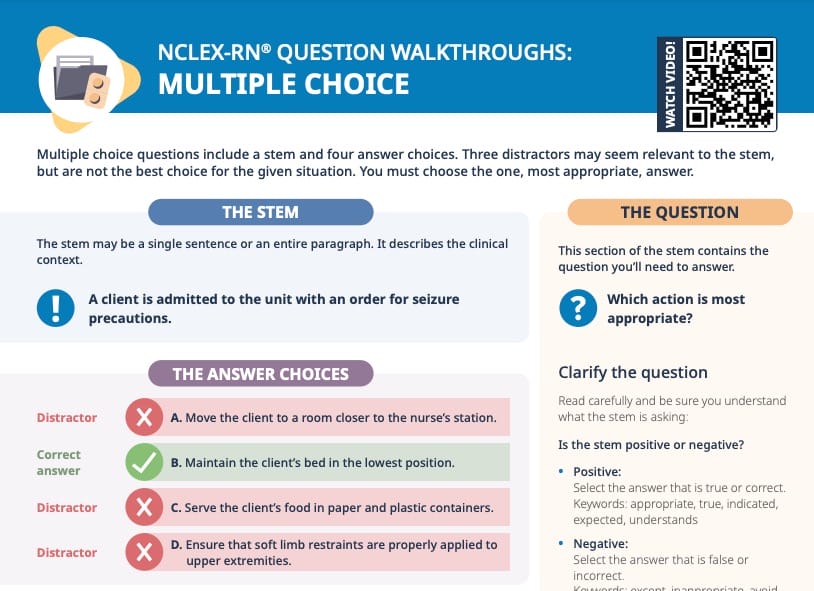#1 Analyze the question, cues, and numbers
What is normal, and what isn’t?
Tip: Whenever you have numerical values in a question stem, make a judgment: Is this high, low, or normal?
- You are dealing with a client who has COPD, so they probably have respiratory problems.
- A normal pH is 7.35 to 7.45, so the pH is lower than normal.
- A CO2 of 46 mm Hg is a little bit higher than normal (35 to 45).
- A HCO3 of 28 mEq/L is considered high, since normal would be 20–26.
The question stem gives us all the values we need for an ABG interpretation, which can result in the four different answers given as our answer choices.
Rephrase the question in your own words
“I am caring for a COPD patient with pH a little too low, CO2 a little too high, and HCO3 too high. As answer choices, I have four descriptions of acid–base imbalances and need to interpret the values to decide which one describes the situation of this patient correctly.”
#2 Differentiate the answer options and eliminate based on the information in the stem
Tip: When all the answer choices look the same at first glance, make it easier for your brain by writing notes about each of them. Decipher what is the same and what is different.
Here, the four answer choices are simply the four different ways an acid–base imbalance can manifest itself: the combinations of acidosis vs alkalosis and respiratory vs metabolic. The task is to match up the values given for this patient with the correct imbalance.
Acidosis vs alkalosis
A pH is the value that determines if a patient is acidotic or alkalotic. So, judging this one already will eliminate 2 answer choices, since we have 2 that say acidosis and 2 that say alkalosis:
- pH of 7.32 is not normal, but a little low.
- It is considered acidotic.
So, we know the correct answer must be acidosis and can eliminate answer choices B and D based on the pH value given.
- Respiratory acidosis, partially compensated
Respiratory alkalosis, partially compensated- Metabolic acidosis, partially compensated
Metabolic alkalosis, partially compensated
Respiratory acidosis vs metabolic acidosis
Having eliminated answers B and D, we know the client is in acidosis. The other values differentiate what causes the acidosis: Is it respiratory or metabolic?
CO2 is considered an acid in the blood, and it is regulated by the lungs in the body. Respiratory acidosis means the acidosis is caused by elevated CO2, which the client in the question does have.
Bicarbonate is considered a base, or alkalotic, which is regulated by the kidneys. Metabolic acidosis, with bicarbonate being a base, would have to be caused by less base, not more, but the HCO3 level in this patient is elevated.
#3 Wrap-up
The low pH tells us the client is in acidosis, and the fact that CO2 is elevated (→ more acid) and bicarbonate is not too low (→ enough base) tells us that the acidosis is respiratory. That makes answer A. “Respiratory acidosis, partially compensated” the correct answer.
The elevated HCO3 value is the body (kidneys) trying to compensate for the acidosis (→ trying to raise alkalotic levels). Since the pH is not quite back to normal, the acidosis is partially compensated.
Recap: COPD and acid–base imbalances
COPD in a nutshell
Chronic obstructive pulmonary disease (COPD) is a chronic, progressive lung disease that involves airway impairment and causes increasing difficulty with breathing. Diagnosis is based on symptom history and pulmonary function tests, while a chest X-ray can rule out other diseases and identify complications.
ABGs will show lower CO2 and rising CO2 depending on the exacerbation and progression of the disease.
Acid–base balance and ABG interpretation
ABG interpretation refers to the interpretation of arterial blood gases. If pH, CO2, and HCO3 values are in a normal range, the body is in homeostasis. If the values are outside of the normal range, the body is experiencing an acid–base imbalance. There are four variations of acid–base imbalances, depending on which of the values are too high or too low:
- Respiratory acidosis
- Metabolic acidosis
- Respiratory alkalosis
- Metabolic alkalosis
Take Lecturio’s online video course on interpreting ABG values here →

